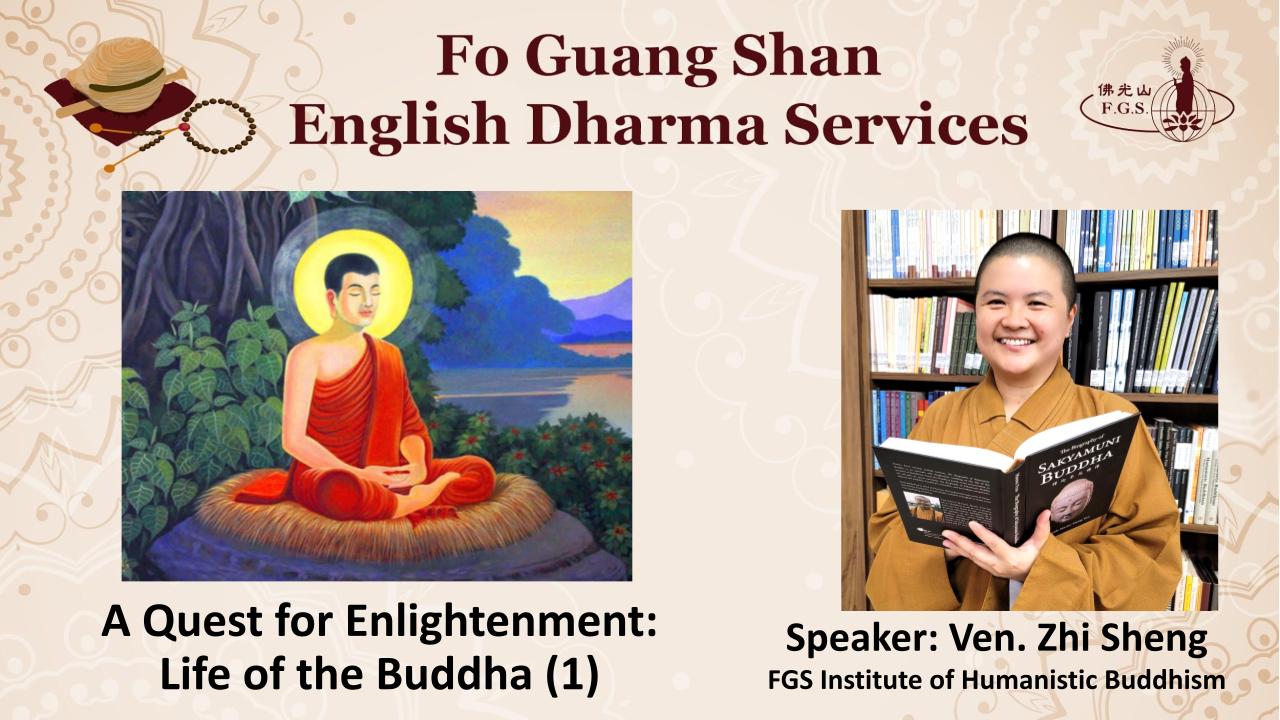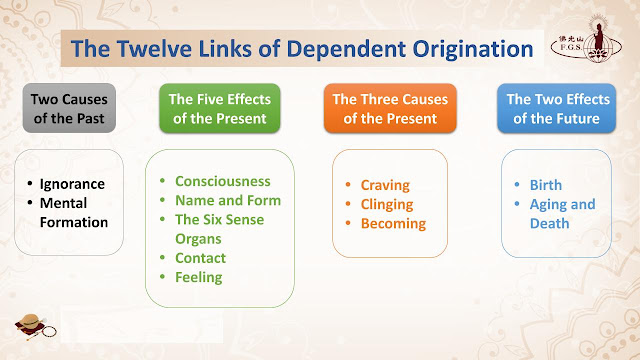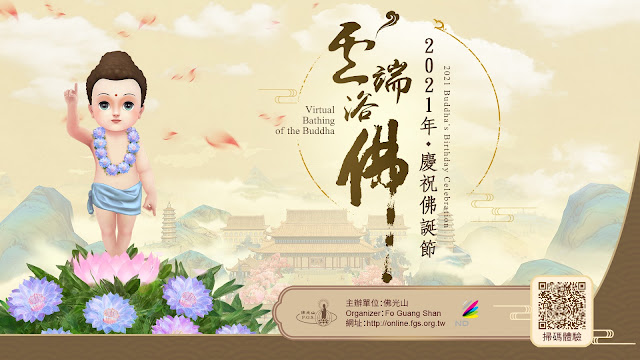
Speaker: Ven. Zhi Sheng
Fo Guang Shan Institute of Humanistic Buddhism
I. Introduction
Hello, welcome to the Fo Guang Shan English Dharma Services. My name is Zhi Sheng and in this series my topic is, “A Quest for Enlightenment: Life of the Buddha.”
I have chosen the Biography of Sakyamuni Buddha written by Venerable Master Hsing Yun as my reference. Venerable Master Hsing Yun wrote this book when he was in his twenties. Drawing from ancient textual sources, it is an intimate and imaginative retelling of the Buddha’s life, from his youth, to his renunciation, to the decades he spent teaching. It depicts the Buddha’s hardships, triumphs, and boundless compassion.
The Life of the Buddha will be discussed in four parts with a theme of “Personal Relationships.” We will begin with the Enlightenment, followed by his Renunciation. Then the Four Sights, and ending with his birth. As you can see, we will be exploring the life of the Buddha in reverse order. Personally, this is how I got to know about the Buddha. I learnt that he was an enlightened being called Sakyamuni Buddha. He renounced the world in search of a way out of life suffering, which was triggered by the Four Sights he saw. And given the month of May, many of us are celebrating his birthday so we will talk about the birth of the Buddha as the last part of this series.
So now, I would like to begin with the Enlightenment of the Buddha. Here are some of the questions we will be discussing.
- What happened upon the Buddha’s enlightenment?
- What did the Buddha come to realize?
- Why did the heavenly beings appear?
- Who received the first teaching of the Buddha?
First of all, just a quick note, before the Buddha attained enlightenment, he was called Siddhartha Gautama.
II. What Happened Upon the Buddha’s Enlightenment
Let us first look at what happened upon the Buddha’s enlightenment?
Quoting from the Biography of Sakyamuni Buddha,
“In a deep state of meditation, Siddhartha was able to perceive the experiences of all his previous lives. He came to know where he had been born, what names he had been called, and what he had done before. A history of millions of births and deaths became clearly known to him. Siddhartha realized that all beings had undergone many births and deaths over limitless time, sometimes as parents, sometimes as children, sometimes as teachers, and sometimes as students, all beings interconnected by causes and conditions.
Siddhartha now saw all phenomena clearly in his mind, and truly understood all things. He saw that birth and death were one and the same, that there was no need for attachment. The prince’s mind and life expanded, uniting with the universe.
For so long the prince had felt that affliction was an incomprehensible force. Why did afflictions arise? As the origins of afflictions clearly surfaced in the prince’s mind, he was finally able to feel joy. The prince examined his thoughts, and then he knew; there could be no mistake he had attained unsurpassed, supreme enlightenment. He had let go of time and place, he had let go of all things, and was finally able to see with no discrimination. He now knew all things clearly; no longer was he asleep, he felt awake. He was enlightened, this was liberation!”
Reflection
Let us now take time to reflect on what we have just read.
The Buddha had been on a quest to find what caused human beings to suffer endlessly? Now, he finally found his answers. He saw his past lives and the interconnectedness of people and things. He was one with the universe. And he knew, he was awakened.
We can try to imagine when we have an “A-ha” moment. That sense of I got it and that is a knowing from within. If it was something that had been bothering you for a long time, and when you finally figured it out, I am sure we will feel pleased and a huge relief.
III. What Did the Buddha Come to Realize?
So what exactly did the Buddha come to realize?
Quoting from the book:
“The Buddha came to understand the truth of the universe. He knew that all things arise through causes and conditions, and that aging, sickness, and death were no different. And the Buddha recognized that suffering arose from a twelve step cycle he would later call the Twelve Links of Dependent Origination.
Therefore, the Buddha realized the causes of birth and death. He made this declaration, “The form of continued existence is birth, the tangle of ignorance is its cause. If sentient beings would not like to die, the only way is not to be born. If they would not like to be born, the only way is to end ignorance. When ignorance ends, mental formation ends. When mental formation ends, consciousness ends. When consciousness ends, name and form end. When name and form end, the six sense organs end.
When the six sense organs end, contact ends. When contact ends, feeling ends. When feeling ends, craving ends, becoming ends. When becoming ends, birth ends. When birth ends, the sorrow and suffering of aging and birth are thereby extinguished. When all defilements are pure, the mind is purified; its all-pervasive light will shine. Only then is enlightenment possible, and only then can one be liberated from birth and death.”
Here, the Buddha had given us the formula to liberation. Did any of you have an “A-ha” moment?
Let us try to understand the Twelve Links of Dependent Origination through a diagram.
As we can see, it has been divided in three periods: The Past, the Present and the Future in terms of the causes and effects.
So, what is the cause of birth? Because of Ignorance and Mental Formation.
These are Two causes of the Past. Ignorance causes us to act blindly and so travelling endlessly in the cycle of birth and death. Mental Formation means karma. Due to our ignorance, we created affliction due to our previous physical, verbal, and mental actions.
There are the Five Effects of the Present, which are Consciousness, Name and Form, the Six Sense Organs, Contact, and Feeling. The consciousness is gained as soon as one enters the womb. It originates from the past actions of affliction. Name and Form refers to the physical body, and one makes Contact with the six sense organs and interacts with the outside world, which then lead to feelings.
So what can we do about it in the present? These are referred to as the Three Causes of the Present, Craving, Clinging, and Becoming. Craving generates clinging for the three kinds of becoming. Craving means to be attached to happiness and reject suffering. There are many kinds of clinging, which led to various physical, verbal, and mental actions, causing suffering for the body and mind in the future. Because of craving, one comes to cling incessantly. This indulgence in the pursuit leads to various actions which will have karmic effects in the future.
Once there is becoming, then there will be effects of the future, which are Birth, and Aging and Death. Therefore, birth refers to a future rebirth, produces the body and mind, resulting in rebirth within the six realms of existence through the four forms of birth. Since birth occurs, the sorrow and suffering of aging, illness and death must occur: this is the natural progression of things, and will continue in future lives.
Can you see the cycle of birth and death in this Twelve Links of Dependent Origination?
This is how we are born again and again in this cycle of existence.
We can also think of the Twelve Links of Dependent Origination like a chain, each link leads to another. The good news is we can break this chain at any point. If one of the links does not arise, then the chain is broken.
In our present, we can pay attention to our Craving and Clinging to begin with. The other links are not so available to us as they are either effects of the present or causes of the past or effects of the future. Therefore, we can focus on the causes of the present, which are Craving and Clinging. In a way, Becoming will be the result of Craving and Clinging. So in order to break the chain, we can start by working on our Craving and Clinging. This is also important aspects to our cultivation.
We can reflect on this from time to time by asking, “How much have we let go?” As our abbot of Fo Guang Shan, Most Venerable Abbot Hsin Bau, he would actually ask many of us at the beginning of the year, “Is our craving less each year? Is our clinging less every year?” This is an important check for us as we embark on our quest to enlightenment.
IV. Why Did the Heavenly Beings Appear?
Next, let’s look at, why did the heavenly beings appear before the Buddha?
Quoting from the book,
“After enlightenment, the Buddha recalled his great vow to liberate all sentient beings. When he remembered how all beings were suffering, he naturally felt great sympathy for them. He thought, “I have fulfilled my vow, attained enlightenment of a buddha, and realized the truth. However, I cannot liberate other beings. The Dharma I have come to realize goes against the worldly, deluded view of ordinary beings. If I were to explain the Dharma to them, they would slander and ridicule it.
Many beings are sunk deep in the abyss of greed, anger, and ignorant views, how could they understand the deep, wondrous truth of liberation? It would be better for me to enter final nirvana, so that none could slander the Dharma and cause themselves harm.”
Reflection
The Buddha had just found the key to liberation. But in order to explain this to others, he began to have doubts. At that time, many people were practicing austerities. The Buddha knew that a lot of people would not be able to accept what he had just realized about the universe.
This is similar to, if we were to encourage someone who has anger issues that meditation would help them become calmer. That person would not believe us at first because they cannot understand how by sitting there breathing would help. They must be willing to try it and only after they have experienced it, that they would be able to understand.
Let us now find out what happened after that?
Quoting from the book,
“With these thoughts in mind, many heavenly beings appeared before the Buddha and spoke, ‘Most honorable, most precious Buddha, we heavenly beings have assembled with utmost reverence and sincerity to pay homage to you. We wish to formally honor you for realizing the liberation of perfect enlightenment. You have gone beyond birth and death. This is true happiness, and a great honor for all beings in this world. You are like a lamp of wisdom, and this world, shrouded as it is in darkness, needs your light.
“Do not worry that ignorant beings will slander the Dharma and commit offenses. That is their own doing! Please uphold your vow and teach the Dharma with your blessed voice. Lead those lost sheep home swiftly, so that they may quickly reach the shore of enlightenment. We pray that you will extend your kindness, unconditionally bestow your compassion, and serve as this world’s great liberator.”
Reflection
So it was the heavenly beings that pleaded to the Buddha to teach in this world. I think we all need to say a big THANK YOU to the heavenly beings. Thank you for encouraging the Buddha to share what he had realized. Can you imagine how this world would be without the teachings of the Buddha? Personally, I can’t imagine, but I know I would be more miserable and lost for sure.
Let’s look further on what happened to the Buddha.
After hearing the sincere request of the heavenly beings, the Buddha was delighted. He immediately departed from underneath the Bodhi tree on Mount Gaya. Bearing in his compassionate heart the wish to liberate all sentient beings, he prepared to journey to the city of Kasi.
Reflection
Before we move to the next section, please think about this question:
If you became enlightened, who would you share first about your discoveries?
For me, I would think of sharing with the people who were part of my journey, those who knew my struggles.
V. Who Received the First Teaching of the Buddha?
Let us now look at what the Buddha did. He thought of his five companions with whom he practiced austerities with. The Buddha went to Deer Park where they resided.
Quoting from the book,
As the Buddha drew near, Ājnāta Kaundinya and the others saw him approaching.
“Is that not Prince Siddhartha? Ājnāta Kaundinya, who was preparing to meditate, asked Asvajit and his other companions.
“Let us pay him no heed. He has abandoned his ascetic practices and indulged in worldly pleasures. He has fallen. When he comes near, let us not greet him.”
“It must be because he is lonely, and has come here to see our companionship. Yes, let us not greet him. We should treat him as we would other visitors. Let us not rise from our seats, or inquire about his journey.”
And so the five made this promise before shutting their eyes tightly, pretending to be immersed in meditation.
However, when the Buddha approached them, they soon forgot their promise. Though they did not wish to see the Buddha, they unconsciously opened their eyes to gaze upon him as he approached. They beseeched the Buddha to take the seat of honor amongst them and bowed to him, touching their foreheads to the ground.
“When you saw me approaching, did you not resolve amongst yourselves not to greet me? Why do you now stand and receive me?”
Facing these five men, the Buddha was like a luminous mirror, illuminating their hearts. The five of them felt awed and ashamed.
“Siddhartha, we would not dare do so,” one answered sincerely as he knelt on the ground.
“Do not call me Siddhartha any longer, for that was my worldly name. I have become a Buddha…”
After that, the Buddha shared about his realization and taught them the Four Noble Truths.
Reflection
From the Buddha’s interaction with the five companions, we can see the Buddha’s wisdom. The Buddha knew that he was not welcome but he was not going to pretend. He acknowledged what is happening by confronting them, “When you saw me approaching, did you not resolve amongst yourselves not to greet me? Why do you now stand and receive me?”
This is a good demonstration of how the Buddha was honest and transparent about what he knew. It also shows the Buddha’s personal relationships with these five companions. At least he felt close enough to them to be that honest.
Sometimes, when we are caught in a situation, we may choose to turn a blind eye or pretend otherwise as we are too afraid to confront the situation. Leaving situations unresolved would not help us in the future. Eventually, it would accumulate and by then it would be too difficult to resolve.
From this, we can learn from the Buddha. Acknowledge the situation, be honest, and stay open to possibilities.
With that, we have come to the end of today’s episode on the Buddha’s enlightenment.
Next week we will be discussing about the Buddha’s “Renunciation.” We hope you will tune in and join us again.
VI. Conclusion
Meanwhile, the month of May is a celebration of the Buddha’s birthday. In view of current pandemic situation, Fo Guang Shan presents “Virtual Bathing of the Buddha,” so you can also join in the celebrations online, in the safety of your home.
Thank you for joining this week’s episode. May you find peace and joy in the Dharma.
If you would like to listen to more contents, don’t forget to subscribe to our channel, Fo Guang Shan English Dharma Services.



